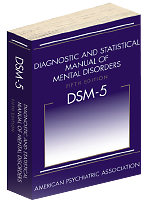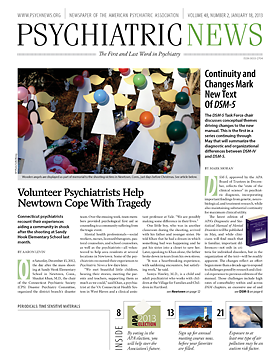DSM-5, approved by the APA Board of Trustees in December, reflects the “state of the clinical science” in psychiatric diagnosis, incorporating important findings from genetic, neurobiological, and treatment research, while also maintaining substantial continuity for maximum clinical utility.
The latest edition of APA’s Diagnostic and Statistical Manual of Mental Disorders will be published in May, and while clinicians will find much that is familiar, important differences—not only in criteria for individual disorders, but in the organization of the text—will be readily apparent. The changes reflect an effort begun more than a decade ago to respond to challenges posed by research and clinical experience to previous editions of the manual. Those challenges include high rates of comorbidity within and across DSM chapters, an excessive use of and reliance on “not otherwise specified” (NOS) criteria, and a growing inability to integrate DSM disorders with the findings from genetic and other research.
In an interview with Psychiatric News, DSM-5 Task Force Chair David Kupfer, M.D., outlined some of the overarching conceptual ideas that have informed the development of diagnostic criteria and the organization of the text. These include incorporation of a developmental approach to psychiatric disorders, recognition of the influence of culture and gender on how psychiatric illness presents in individual patients, a move toward the use of dimensional measures to rate severity and disaggregate symptoms that tend to occur across multiple disorders, harmonization of the text with ICD, and integration of genetic and neurobiological findings by grouping clusters of disorders that share genetic or neurobiological substrates.
DSM-5 consists of three sections: Section 1 will give an introduction to DSM-5 with instructions on how to use the updated manual; Section 2 will outline the categorical diagnoses according to a revised chapter organization that eliminates the multiaxial system; and Section 3 will include conditions that require further research before their consideration as formal diagnoses, as well as cultural formulations and other information.
Kupfer said the classification of disorders is largely harmonized with the World Health Organization’s International Classification of Diseases (ICD) so that the DSM criteria sets are more parallel with the proposed ICD-11. In DSM-5 both the current ICD-9-CM and the future standard ICD-10-CM codes (scheduled for 2014) are attached to the relevant disorders in the classification.
He noted as well that Section 3 contains a detailed discussion of culture and diagnosis, including tools for in-depth cultural assessment and a description of some common cultural syndromes, idioms of distress, and causal explanations relevant to clinical practice.
Although the new manual retains a categorical listing of separate disorders, an important change to DSM-5 is the incorporation of dimensional measures of severity for a number of disorders, reflecting what a considerable body of research—as well as clinical observation—has revealed: that the boundaries between many disorder “categories” are more fluid over the life course than was previously understood, and many symptoms assigned to a single disorder may occur, at varying levels of severity, in many other disorders. So, for instance, the criteria for autism spectrum disorder include three levels of severity for the two principal symptoms—“deficits in social communication and social interaction” and “restrictive and repetitive behavior patterns”—to indicate the level of supportive services required by an individual patient (see related article above).
While the categorical listing of personality disorders in DSM-5 remains virtually unchanged from the previous edition, Section 3 also contains a “hybrid” model incorporating dimensional measures to guide future research.
Kupfer said the order of chapters within Section 2 reflects a “lifespan” approach, with disorders more frequently diagnosed in childhood at the beginning of the manual—hence the first chapter on neurodevelopmental disorders, including autism spectrum disorder and learning disorders—and disorders more applicable to older adulthood (such as neurocognitive disorders) at the end of the manual. Within the text, subheadings on development and course provide descriptions of how disorder presentations may change across the lifespan.
Finally, he emphasized that the revised chapter structure was informed by recent research in neuroscience and by emerging genetic linkages between diagnostic groups. Genetic and physiologic risk factors, prognostic indicators, and some putative biologic markers are highlighted in the text. “This new structure should improve clinicians’ ability to identify diagnoses in a disorder spectrum based on common neurocircuitry, genetic vulnerability, and environmental stressors,” he said. ■

